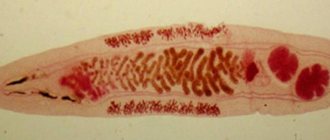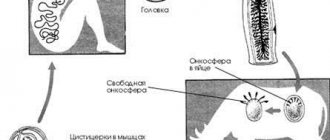How worms are transmitted from dogs and cats to humans
The main reason a person becomes infected with worms is poor hand hygiene. The eggs land on the skin and are then transferred to the oral cavity. For example, when an owner strokes an infected cat that has previously licked its fur. Worms can also enter the human body through contact with surfaces on which eggs remain. If you don't use gloves when cleaning your cat's litter box or picking up after your dog on a walk, you also run the risk of getting infected.
If you suspect that your four-legged dog has been attacked by parasites, you should contact a veterinarian. He will determine the type of worms and tell you whether it is dangerous for humans. Afterwards he will prescribe treatment.
Are worms contagious?
Eggs of parasitic worms can pass from person to person in different ways:
- If, for example, a mother feeds her child with dirty hands, the subungual space of which contains eggs of pinworms and roundworms.
- Parasite eggs can enter the water with tiny particles of feces. This is how a person can become infected with giardiasis from another person. Cysts remain viable even in chlorinated water, so infection can occur in a pool where a carrier suffering from diarrhea has been. Swimming in the pool is prohibited from swallowing water.
- Invasion through the placenta is also a variant of transmission of helminthiasis from person to person. In addition to intrauterine infection, the fetus can get helminthiasis while moving through the birth canal. After all, the eggs and larvae of various worms accumulate in the anus, which is adjacent to the vagina.
- A helminthic infestation can also affect infants. He won't get worms through breast milk, but because of his dirty body and hands, he will.
- Amoebiasis ranks second in the number of deaths after malaria. It can be extraintestinal and intestinal. The symptoms resemble pulmonary lesions, colitis and dysentery. A healthy person can become infected from a patient during sexual intercourse, for example, with giardiasis and amebiasis in the case of homosexual relations.
What worms are transmitted to humans from dogs and cats?
Most types of worms are not dangerous for pet owners: even once they enter the human body, the helminths die or leave the body. Children are at risk - they are the ones who neglect hygiene rules. Let's look at the common types of parasites that live in the human body.
- Tapeworms (cestodes class)
There are about 3,500 species of tapeworms. One of the most dangerous is echinococcus. It lives primarily in the intestines of dogs, but can also be found in cats. Animals become infected by eating meat with worms. It is not the worm itself that is dangerous to humans, but its larvae. They penetrate the walls of the stomach and enter the systemic bloodstream. The disease is characterized by the formation of cysts in the liver. You can get rid of them surgically. Echinococci affect the heart, spleen, gall bladder, brain and spinal cord, and lungs.
- Roundworms and threadworms (class nematodes)
The class of nematodes is represented by roundworms and threadworms. A common roundworm is transmitted through hands. The parasite multiplies in the small intestine and affects the lungs, brain, respiratory organs, and heart. Symptoms of the disease: anemia, problems with stool (diarrhea, diarrhea), allergies, bleeding.
If a sick animal lives at home, a person can contract toxocariasis. It is caused by canine and feline Toxocara. You can become infected with Toxocara when cleaning your pet's litter box; the eggs are transmitted by airborne droplets. The parasite can live in the bodies of cats and dogs for years without causing discomfort. A person suffers an uncharacteristic illness more severely. The danger of toxocariasis lies in the difficulty of early diagnosis. Treatment may require several years.
Causes of helminthiases
A question that concerns many is what causes worms in humans and how one can become infected with them. Parasitic infections are quite common today. You can pick up worms anywhere if you don’t follow the rules of basic hygiene.
Helminths can be different. These are both tapeworms and roundworms. Most of them have suction cups, with which they attach to the mucous membranes of organs. The variety of parasites is so great that it is impossible to list them all.
Some types of worms do not pose a serious danger and can be easily removed from the body. Some helminths can even lead to death. In most cases, children are susceptible to infection. When parasites are present in the body, characteristic symptoms occur.
The stool may be disturbed, epigastric pain appears, and the general condition is unsatisfactory.
The most dangerous thing is that helminths can create obstruction in the lumen of any organ. Additionally, they accumulate decay products of their vital functions, which leads to intoxication and the appearance of many concomitant diseases.
A person can lose a lot of weight with a normal diet, sleep disturbances appear and immune defense decreases. Identifying worms at an early stage is extremely important. Worms, their other medical name is helminths, can live in humans for a long time.
The disease they cause is called helminthiasis or helminthic infestation. Today, 300 types of helminthic diseases are known, which are divided into:
- intestinal. In this case, the intestine becomes the habitat;
- extraintestinal. Their places of residence and reproduction are the lungs, liver, muscles and other organs.
The most common diseases caused by helminths are ascariasis and enterobiasis.
The reason why a person develops ascariasis lies in the infection of the body with roundworms. These are worms, the length of which can reach up to 20 cm. The place where these parasites most often live is the area of the small intestine. This makes them difficult to detect during stool examination.
Roundworms can exist in the human body for many years. Over time, the presence of these parasites contributes to the deterioration of general health with damage to some organs.
Infection with pinworms - enterobiasis - is also a common helminthic disease. The habitat of these worms is the final section of the small and cecum of humans.
Many people falsely believe that the appearance of parasites in the body is associated only with dirt that enters the body. This is wrong.
The most dangerous types of helminths enter the human body when eating poorly processed meat: undercooked or undercooked. This is especially true for pork, lamb and beef. During their lifetime, animals could be infected with dangerous types of worms, the spores of which were preserved in the meat.
They are resilient and are destroyed only when exposed to high temperatures for a long time. In order to destroy the larvae, the meat must be cooked for at least 2 hours at a temperature of 100ºC. Otherwise, eggs may be preserved in it, which, when they enter the body, begin their active life activity.
The most dangerous type of worm is Trichinella. This is the type of parasite that can be found in meat. If you become infected with such worms, the disease can be fatal.
Another common type of infection is eating raw or dried fish. At the same time, the risk of eggs entering the body is very high. The danger increases when consuming fish from northern latitudes. In this case, you can become infected with opisthorchiasis.
Worms can reach significant sizes and often parasitize the gastrointestinal tract. It is very important to always cook fish. You should not eat it raw, especially for river fish.
You can boil or fry it, but eating it dried is dangerous.
Many helminth eggs are highly resistant to unfavorable conditions, so sometimes the only way out is heat treatment.
The main carriers of parasites
You can become infected with helminths in various ways. In most cases, a person gets worms through soil that is contaminated with feces. The reasons are as follows:
- Eating poorly washed fruits and vegetables;
- Ignoring hygiene rules after work has been done with soil, etc.
The main carriers of infection are flies. The eggworm, located on their paws and proboscis, is transferred to food products. The result of this will be worms in humans.
You must be careful when swimming in a pond; if you accidentally get water into your mouth, you can catch an infection in the form of helminths. Larvae and eggs of parasites are found in poorly cooked meat from animals that have been infected with worms, for example, undercooked kebab.
It is entirely possible for worm larvae to enter the human body along with dust; for example, it is enough to consume:
- strawberries straight from the bush;
- an apple from a tree;
- greens without first rinsing them under running water.
Worms are worms that thrive in the bodies of various animals. Dogs and cats are dangerous. You can also get infected from poorly fried fish.
In children, helminths can appear when playing:
- In the sandbox;
- On the beach;
- With pets.
All pets must be examined for the presence of worms. Before allowing children to play with them, it is necessary to treat dogs and cats with special medications.
You can become infected with these parasites by consuming the following low-quality products:
- scrambled eggs from poorly washed eggs;
- salo;
- caviar
Drinks poured into plastic glasses and food sold from stalls on the street pose some danger.
If you follow simple hygiene rules, this will help reduce the likelihood of infection with worms. To do this you need:
- Vegetables and herbs that are eaten fresh should be washed under running water and treated with boiling water;
- Refuse products - fish, meat, caviar, salted fish, prepared manually - without heat treatment;
- Do not drink raw water from open sources.
A prerequisite that must be met in order to prevent parasites from entering the body is frequent hand washing, keeping the kitchen area and toilet clean and tidy.
Infection with parasites can also occur due to poor personal hygiene, especially by children. It is very dangerous when a child plays in the sandbox and puts his hands in his mouth. He can pick up not only E. coli, but also dangerous types of helminths, the eggs of which are found in animal feces.
If a child develops a high fever, nausea, vomiting, and loses weight before our eyes, then these are the first symptoms of helminth infection. In this case, it is better not to delay visiting the doctor.
Worms can also appear through contact with pets. Some people are beginning to refute this possibility, claiming that cats never leave the house. However, worm eggs are very easy to carry on shoes, and pets always lick themselves, introducing the larvae into the gastrointestinal tract.
After contact with a cat or dog, you must wash your hands thoroughly. It is unacceptable for an animal to eat food from a child’s or adult’s plate.
Another common route of infection is vegetables, fruits and herbs. Most worms lay their eggs in the soil. Eating unwashed fruits, vegetables or greens can lead to infection with whipworms, roundworms, pinworms and hookworms.
Some people take serious risks by eating fruits directly from the garden, without first washing them. The development cycle of some worms is quite long, so recognizing a parasite in yourself in the initial stages is not so easy.
For example, roundworms can reach 30 cm, or even more. Over time, they clog the lumen of the small intestine, leading to obstruction. In this case, severe symptoms arise.
The only guarantee that helps reduce the risk of infection with worms is heat treatment of meat, fish, washing plant foods and hands.
It is also necessary to remember about the household method of infection. If one member of the family has helminths, then the rest of the household may also develop them. Most modes of infection are via the fecal-oral route. In this case, a certain number of eggs are released in the feces.
If you do not wash your hands and eat something after defecation, re-infection may occur. To reduce the risk of helminths, it is recommended to follow the rules of hygiene and be sure to take preventive measures in relation to pets.
Once every 3-4 months you need to give cats and dogs special anthelmintic drugs.
To reduce the toxic effect of taking them, you should use drops that are applied to the withers. People who suspect they have helminths or see fragments of them in their stool should definitely consult a doctor for advice.
You cannot take any measures on your own, since you can cause harm to the body, and folk remedies are effective only against certain types of helminths that live in the gastrointestinal tract. Only a specialist can select the dosage.
Classification of helminths
Helminths are parasitic worms. Helminth infections are chronic parasitic diseases that affect many human organ systems. More than 250 species of worms are known, in the Russian Federation there are about 90 species. Infection and transmission of parasites depends on the type of worms, the characteristics of their activity and life cycles.
Worms in humans cause damage to those organs and systems that they, the larvae or their eggs use for their vital functions.
Common helminthic infestations include diseases such as ascariasis, taeniasis, teniarinchiosis, enterobiasis, echinococcosis, caused by parasitic worms. Taking into account the morphological and anatomical features, there are flat and round worms:
- Flatworms include representatives of the class of flukes (liver fluke, cat fluke), tapeworms, or cestodes (tapeworms, bovine and porcine flukes, echinococcus).
- Roundworms that cause helminthiasis include roundworms, pinworms, and trichinella (the causative agent of trichinosis).
What types of worms do humans have based on localization?
- Intestinal;
- Extraintestinal;
- Fabric.
According to the type of life cycle, geo- and biohelminths are distinguished:
- Geohelminths have only one host, but the eggs and larvae need to stay in the ground.
- Biohelminths need a change of hosts - intermediate and final.
Various human worms use both definitive and intermediate hosts.
The second option is more dangerous: after hatching from the egg, the worm can travel through the bloodstream to such vital organs as the heart, brain, eye, causing severe pathologies or death. Source: “mydoctorhouse.ru; wikiparazit.ru; parazitipro.ru «
Treatment of helminthic infestation (helminthiasis)
To get rid of helminths, the owner and pet must undergo treatment. To make an accurate diagnosis, you need to consult a doctor and veterinarian. They will determine the type of helminth and prescribe an effective medicine, taking into account the individual characteristics of the patient’s body.
There are broad-spectrum drugs that can destroy tapeworms, roundworms, threadworms and flukes, and are also effective against mixed infestations.
If the disease is advanced, auxiliary measures may be needed: taking enterosorbents that will remove toxins, enzyme preparations to restore the functioning of the digestive system, antihistamines if worms provoke an allergy. Afterwards you should take a multivitamin complex.
Methods of infection with worms through contact with a sick person
Depending on the type of helminth, the time it takes for the parasite to develop in the body is different.
Some species never transition from the larval stage to an adult at all, while others grow to meters in size and reproduce by mating. Let's consider ways of contracting worms from another person.
From child to child
If a child is not taught to wash his hands regularly, then infection of helminths between children occurs quickly. It is impossible to diagnose the presence of worms in a baby by eye. Most often, roundworms and pinworms are transmitted through contact with an infected child or person.
Bed dress
Worms can be transmitted through someone else's bed, although the statistics of such infection are low. However, it is recommended to always iron bed linen after washing.
From mother to child
This option is possible if a pregnant woman has worms that can pass into the placenta through the bloodstream.
There is a possibility of infection at the moment when the child passes through the birth canal. Worms that accumulate in the anal area easily enter the body during childbirth.
Mother's milk
It is not precisely confirmed whether worms are transmitted through mother's milk. However, infection can occur due to the mother's failure to comply with basic hygiene rules.
Sexual contact
If one of the partners is infected, then the probability of infecting the other partner is almost 100%. Giardia is transmitted in this way.
Airborne method
Such a transmissible variant of infection is completely excluded.
Only negligence in personal hygiene or contact with the belongings of an infected person can lead to infection!
Kisses
The method of transmission of helminthic infestations through kisses is quite complex. Essentially, helminths must accumulate in a person’s mouth, and this situation is unlikely. You can become infected more quickly through the mouth by eating dirty vegetables or fruits.
Dishes
Is it possible to become infected with worms through clean dishes? The probability is practically non-existent. But even if there is contaminated fish on a clean plate, you can become infected.
Contact and household
This method of becoming infected with worms is the most common and is associated exclusively with non-compliance with hygiene procedures. If there is an infected person in the family, then infection of the rest of the family occurs quickly.
Children and adults should not be allowed to bite their nails, pens or pencils.
Prevention of infection with worms from cats and dogs
- All pets should be given anthelmintic drugs at least once a quarter.
- Do not feed your pet raw meat and fish.
- Wash your hands after contact with animals, especially thoroughly after cleaning their sleeping and feeding areas.
- Clean your apartment regularly with disinfectants.
- Carry out drug prevention of helminthiasis among all family members.
- It is recommended to use flea drops or a collar, as some types of worms are transmitted through fleas and lice.
Prevention and hygiene will reduce the risk of infection with worms in both cats and dogs to a minimum.
Sources and routes of infection
There are several ways you can become infected with worms:
- Contact and household through objects, pets, other people;
- Nutritional – due to lack of personal hygiene, poorly washed foods or raw meat, fish;
- Transmissible - caused by insect bites;
- Active - transmission route through swimming in contaminated water, through mucous membranes or contact with soil. In this case, parasites enter the body through damage to the skin.
Every person should know how to become infected with worms or the routes of transmission of infection. After all, the carrier does not always know about the presence of the parasite in the body; people often spend years being treated for diseases of the stomach and liver, not realizing that these are symptoms of worms. There are several ways in which worms are transmitted from person to person:
- From the carrier. The waste products of helminths can be on the clothes of an infected patient, under the nails, on the skin and settle on all objects that the carrier touches. The list of transmission sources is extensive:
- bed and table linen;
- personal items;
- common items;
- door handles;
- any surfaces;
- everything that the wearer handled with his hands, including phones, keyboards, etc.
Children's medications for enterobiasis
In this case, transmission occurs through any contact: handshake, touch. Let's take a closer look at whether it is possible to become infected with worms from another person.
- Does a breastfeeding child become infected from the mother? Yes. This can happen during pregnancy through the blood, placenta, during childbirth, if there is a rupture of the perineum or if the mother’s body is poorly washed and there are worm eggs on it, during feeding there will be contact with the baby’s skin and infection is guaranteed.
Fact! With an ordinary kiss, it is impossible to contract worms from a child and infect him. Mature individuals and larvae do not live in the oral area, so it is practically impossible to transmit ordinary parasites through a kiss. You can become infected with parasites by kissing a child along with uneaten food contaminated with helminths - this is infection through food, not through a kiss! Therefore, it is extremely important not to chew food for your baby and then pass it through the mouth.
- Are worms transmitted in swimming pools, gyms, baths and saunas? Very fast and simple. Swimming in contaminated water, sharing a locker with a carrier, or touching is enough to get helminth eggs on your fingers and body.
- You can get infected through dishes, but only if they are dirty, long infested with flies and/or with remains of animal blood.
- You can get infected through the bed if enough people have already used the linen and it has not been washed.
- Are worms transmitted sexually? Yes. There is contact with the skin, a condom and other methods of contraception are powerless.
In everyday life, infestations lie in wait everywhere: there is no guarantee that any person is not a carrier. Be it an inspector who took your license for inspection or an employee who asked for a stapler. Helminth eggs maintain viability in the external environment for a long time, and in the absence of preventive measures, the result is the same - infection.
There are ways of transmitting infection through water and soil, so you should not rinse dishes or wash your hands in open water or sit down at the table without cleaning yourself up after working in the garden or relaxing on the beach. Sand and soil along with water are the favorite habitat of invasions. There are many options for how you can become infected with parasites, but it is impossible to visually distinguish the carrier. The solution is to prevent helminthiasis.
Information about the pathology
Medicine knows many parasites for which the human body is a carrier and source of nutrition; experts divide helminths into two main subcategories:
- Nematodes or roundworms;
- Flatworms.
Worms are parasitic organisms that live in the bodies of animals or people, with the possibility of damaging tissue structures, specific symptomatic manifestations and disturbances in the general health of the patient. The size of parasites can vary from a few millimeters to tens of meters.
The manifestations of the pathological process are similar to many diseases that cause damage to the liver, pancreas, and gastrointestinal tract. How do worms enter the human body? Despite the common misconception about poor hand hygiene as the only way parasites are transmitted, there are many ways the pathogen can enter the body.
How contagious are worms in humans? Any type of disease is characterized by increased aggressiveness, worsening the patient’s well-being without the necessary symptomatic therapy. A person in the phase of active reproduction of parasites unwittingly becomes a source of infection for others.
What helminths can be transmitted between people
Parasites are divided into those that populate the intestinal lumen, and extraintestinal ones - they live in the muscles, liver, lungs, heart, and other organs. Worms that are transmitted from person to person include pinworms (cause enterobiasis) and roundworms (causes of ascariasis), as well as whipworms.
Pinworms
Small worms (up to 1 cm in length) are white-yellow or dark in color, their body has rounded and sharp ends. Activated at night. Females crawl out of the anus, spread to the surrounding skin and lay eggs, then die. Because of this, the anal area becomes very itchy. A person scratches this place, the eggs remain on the fingers and under the nails, from where they easily get on food, door handles, and toys. Cockroaches and flies infest food, furniture and other objects.
The development cycle of pinworms is very intense. At a temperature of 34 to 36 degrees, high humidity (such conditions in the perineum area, folds of skin around the anus), moving larvae mature for 6 hours.
Once again in the human intestine, pinworms turn into larvae after 2 weeks to a month, and after 10-12 days they become adults that live up to 6 weeks.
Roundworms
Worms that live inside the small intestine. They come out with feces and can remain outside the human body for 7 years or more. At temperatures from 12 to 40 degrees, the development of the larvae in moist soil takes up to 3 weeks. It enters the human body with poorly processed berries, vegetables, and contaminated water. From the intestines, roundworms are able to penetrate into the vascular bed, heart, and alveoli of the lungs.
The length of the roundworm reaches 20 cm. Females of the parasite are very fertile - each lays up to 250 thousand eggs per day.
Whipworm
The body of the worm is thin, gray-white, 3-6 cm long. The larvae that mature inside the intestines come out with feces, then are re-swallowed by a person along with food, dirt, and dust. In 3 months the larva reaches its adult form. The female lays up to 20 thousand eggs per day.
A round filamentous worm inhabits the intestines and provokes the disease trichuriasis.
Truth and myths about worms in humans
There are many misconceptions regarding whether it is possible to become infected with worms from another person.
Worms are not transmitted from mother to child
In fact, parasites are able to penetrate the blood and spread to all organs, including the uterus. Having crossed the placental barrier, the worms reach the child. Infection with roundworms also often occurs during childbirth.
You can't get an infection through a handshake
This opinion is wrong. Shaking hands is one of the most common ways to spread helminths (especially pinworms).
Eating spicy food is a means of preventing helminthiasis
Don't rely on the miraculous power of spices. Those of them that have a pungent taste are not able to affect the viability of larvae and adults.











